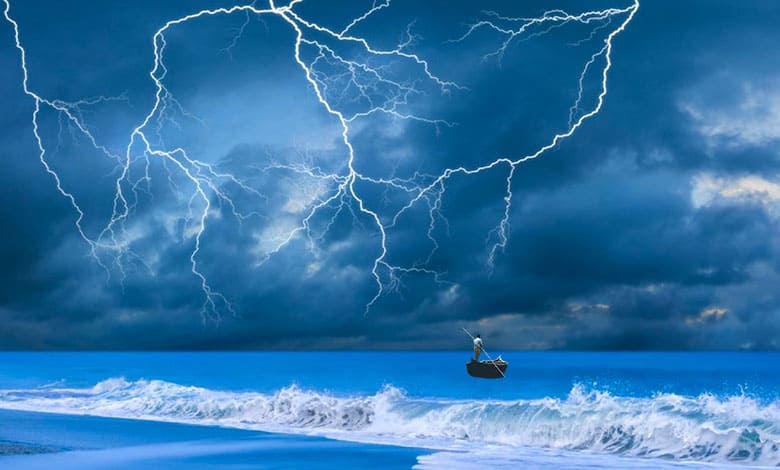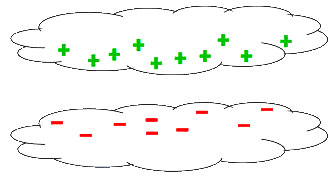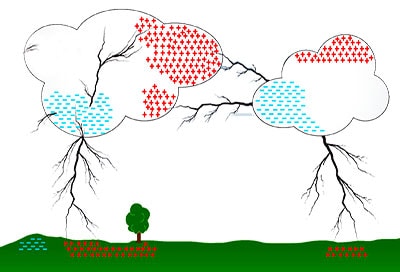
Lightning is an atmospheric discharge of electricity accompanied by thunder, typically during a thunderstorm. Volcanic activity can also cause lightning. Lightning and thunder happen because of electrostatic discharge between the cloud and the ground below. It disturbs the air and the sound of thunder that you hear.
So, lightning is one of the most common and incredible natural phenomena. It’s a common occurrence during summer. Globally, there are approximately 100 lightning strikes per second. The most significant concentrations of lightning strikes are in Central Africa, South America, and the Himalayas. Beautiful, fascinating, and potentially deadly lightning strikes millions of times per day worldwide.
Different types of lightning:
- Cloud-to-ground lightning.
- Intra cloud lightning.
- Ball lightning.
- Cloud-to-cloud lightning.
- Positive cloud-to-ground lightning.
From the buildup of electrical charges in storm clouds to the explosive sound waves of thunder, each flash and rumble tells a story of energy, transformation, and the interconnectedness of Earth’s systems.
How Do Clouds Develop Charges?
We need to know more about clouds to learn about lighting because clouds make lightning. During summers, the ground is hot and hits the air above it. As the warm air rises, the cold temperatures at the highest cool the water vapor down, forming a cloud.

As more and more air continues to rise, the clouds get bigger and bigger. If the temperature at the top of the clouds falls below freezing, the water vapor turns into ice. Now, the cloud becomes a thundercloud. Many small bits of ice bump into each other as they move around clouds, developing an electric charge.
The positively charged particles accumulate at the top of the cloud, and the negatively charged particles sink to the bottom of the top. The more the ice particles will rub against each other, the more the cloud gets charged. A huge accumulation of charges at the bottom of the cloud with a strong negative charge repels the electrons on the ground’s surface and makes the ground positively charged.
Since these charges are oppositely charged, they should attract each other and make each other neutral. Why does that not happen? There is air between these particles, which does not easily let electric charges flow through. So, the charges go on accumulating without becoming neutral. When the magnitude of the accumulated charges becomes so large that it can overcome air resistance, thunderclouds can be tall and several miles high. Air movement, usually up and down, can cause charge movement inside the cloud in many cases.
What causes lightning and thunder?
Lightning and thunder are both natural phenomena that occur during thunderstorms. Here’s a brief explanation of what causes lightning and thunder:
Lightning: Lightning is an electrical discharge between different charged regions within a thunderstorm cloud or between the cloud and the ground. The exact process of lightning formation is complex but involves separating positive and negative charges within the storm cloud.
Charge Separation: Thunderstorms develop an electric field as rising air currents carry water droplets and ice particles upward. Collisions between these particles cause some to become positively charged while others become negatively charged. The positive charges accumulate near the top of the cloud, while the negative charges accumulate in the lower parts.
Electrical Breakdown: As the charge separation intensifies, the electric field within and between the cloud and the ground strengthens. Eventually, the electrical resistance of the surrounding air is overcome, and a pathway is formed for the electrical discharge to occur.
Lightning Discharge: Lightning can take various forms, but cloud-to-ground lightning is the most common type. It involves a downward-moving channel of electrons (negative charges) called a stepped leader, which is attracted to a positively charged region on the ground or in another cloud. When the stepped leader connects with a positively charged area, a return stroke of positive charge moves upward, forming the visible lightning bolt.
Thunder: Thunder is the sound produced by air’s rapid expansion and contraction surrounding a lightning channel. When lightning occurs, it rapidly heats the surrounding air to temperatures hotter than the sun’s surface. This intense heating causes the air to expand explosively, creating a shockwave that travels outward.
Shockwave Generation: The rapid expansion of heated air creates a shockwave that moves outward from the lightning channel. The shockwave compresses and pushes nearby air molecules, creating a sudden increase in air pressure.
Sound Propagation: The rapid expansion and contraction of air produce vibrations, which propagate as sound waves through the atmosphere. These sound waves reach our ears as thunder’s characteristic rumbling or cracking sound.
Distance and Timing: Since light travels much faster than sound, we see lightning almost instantly when it occurs, while the sound of thunder takes longer to reach us. By counting the seconds between seeing the lightning and hearing the thunder, we can estimate the distance to the lightning strike. Each second represents approximately 340 meters (1,100 feet) of distance.
So, lightning is a sudden discharge of static electricity from within a storm cloud. It’s about the separation of positive and negative charges necessary for lightning. It is caused when water droplets rise and collide with falling hailstones. So even though there might be a thunderstorm that doesn’t have hail in it. There are hailstones in the thunderstorms, and they melt before they get to the ground.

The hailstones then strip electrons that have a negative charge from the water droplets and cause the top of the cloud to become positively charged. Static electricity then builds up between the earth and the cloud. Eventually, a negatively charged spark and the form of an invisible lightning bolt come down the cloud.
How does thunder occur? The thunder is nothing but the collision of clouds. It’s the sound that is caused by lightning. The intense heat from lightning causes the surrounding air to rapidly expand and create a sonic wave you hear as thunder.
Explanation of lightning and thunder: The cloud has become polarized, with the positive charge on top and the negative charge on the bottom. The positive charges are from the protons, which are stuck in the nuclei of the atoms. The electrons’ negative charges are much more easily moved, and all the electrons in the clouds repel them. So, these electrons tend to get pushed away. They get pushed deeper into the ground or spread out by the negative charge in the cloud above.
The cloud’s negative electrons attract the positive objects on the ground. If the force of attraction is strong enough, the electrons will jump across the gap. Suddenly, this discharge may take place in between clouds or between the clouds. When the electric discharge occurs, each lightning flash we see may get between the cloud and the earth. There is a negative charge in the cloud and a positive charge. As we know, unlike charges attract each other. So, the negative and positive charges meet, producing streaks of bright light.
Meanwhile, a similar finger called a streamer reaches out from its target, and when they meet zap in a fraction of a second, up to a billion volts of electricity flow along the lightning path. Then, a brilliant flash of light flows along the channel as a return stroke.
This intense flow of energy superheats the air in the channel. It’s causing it to expand violently, sending out a shock wave that slams the air molecules into those surrounding the lightning path, which sets off a thunderclap. So, where does all this charge buildup come from? There’s some debate about this, but the basic idea is that collisions between snow pellets falling toward the ground with ice crystals being lofted upwards result in the exchange of charge in the colder upper half of the cloud.
The snow pellets pick up a negative charge during these collisions, while the ice crystals become positively charged in the warmer lower half of the cloud. The opposite occurs as the snow pellets fall and melt into raindrops, then the ice crystals rise. This results in the cloud having three distinct charged regions.
One of the persistent mysteries about lightning is how it’s initiated. Because the immense charge buildup inside the cloud doesn’t seem enough to overcome air resistance, each lightning flash we see may get a bit of extraterrestrial kick from a cosmic ray particle.
These particles stream down from space, smacking into air molecules and producing showers of charged particles. Inside a thunderstorm, this would form ionized trails, acting as freeways of lower air resistance for the charge to follow and set off a lightning bolt.
Some of the most recent research has revealed that lightning can generate antimatter and gamma rays—some of the most powerful pulses of light in the known universe. Lightning can also travel from ground to cloud and from cloud to ground. It can also travel from one cloud to another. The lightning is seeking the easiest route to the ground. The negative charge is then dispersed through the ground and neutralizes that region’s positive charge.
What causes lightning to strike a person?
Lightning strikes a person when their body becomes a part of the lightning’s path to the ground. Lightning is an electrical discharge caused by imbalances between storm clouds and the ground or within the clouds themselves. Here’s a simplified explanation of the factors and conditions that can lead to a person being struck by lightning:
- Path of Least Resistance
Lightning seeks the easiest path to the ground. Objects that are taller or have better conductivity (ability to carry electrical current) provide a more accessible path. When a person is standing in an open area, especially if they are the tallest object around (like in a field, on a hill, or under a solitary tree), they can become the most direct path for the lightning to reach the ground.
- Pointed Objects and Sharp Angles
Like other objects, the human body can induce a charge when under a charged cloud. Pointed parts of the body or items being held (like umbrellas or golf clubs) can enhance the electric field locally. They can initiate a channel of ionized air, or “leader,” reaching up towards the downward-moving leader from the cloud, increasing the chances of being struck.
- Proximity to a Lightning Strike
A person doesn’t need to be directly hit by the main lightning channel to be struck. A side flash (or side strike) occurs when lightning strikes a taller object nearby, and part of the current jumps to the person who may be a better conductor to the ground.
Ground current effects are another danger. When lightning strikes a nearby object or the ground, the current can spread along the ground surface. If a person is standing near the strike point, the current can travel up one leg and down the other to continue to the ground, causing injury or death.
- Activities During a Storm
Engaging in activities that increase exposure to lightning, such as being in open spaces, swimming, or taking shelter under trees, significantly increases the risk of being struck.
- Electrical Conductivity of Wet Surfaces
Wet surfaces, including wet skin or wet clothing, can improve conductivity, making it easier for the lightning’s electrical current to travel through a person’s body.
Safety Tips to Avoid Lightning Strikes
Seek Shelter: The safest place during a lightning storm is indoors, away from windows, plumbing, and electrical appliances.
Avoid Open Fields: Do not be the tallest object in an area. Stay away from open fields, hilltops, and open water.
Stay Low: If caught in an open area, crouch low with minimal contact with the ground, but do not lie flat, as this increases your contact with the ground and the risk of ground current affecting you.
Avoid Trees and Tall Objects: Taking shelter under a tree is dangerous as lightning can strike the tree and jump to you or cause a ground current.
Stay in a Car: If no building is available, a car (with a metal top) can offer protection as the metal frame can direct the lightning around the occupants and into the ground.
Understanding these factors and taking appropriate precautions can significantly reduce the chances of being struck by lightning.
What causes lightning without thunder?
When you see lightning but don’t hear thunder, it’s usually because the lightning is too far away for its thunder to reach you. Thunder is the sound of rapid expansion and contraction of air heated by a lightning bolt. Here’s a closer look at why you might see lightning without hearing thunder:
Distance
Sound Fades with Distance: Thunder can generally be heard up to about 10 miles (approximately 16 kilometers) from the lightning strike under ideal conditions. If the lightning occurs farther away than this, you might see the flash but not hear the thunder because the sound dissipates as it travels through the air, eventually becoming too faint to hear.
Curvature of the Earth: The curvature of the Earth can also limit how far thunder can be heard. Lightning that strikes beyond the horizon might be visible, especially at night, but the sound of the thunder might not reach you because the Earth curves away from the sound path.
Atmospheric Conditions
Atmospheric Absorption: The atmosphere can absorb sound, especially at higher frequencies. Humidity, wind direction, and temperature gradients in the atmosphere can affect how sound travels and how far it can be heard.
Temperature Inversion: Under normal conditions, air temperature decreases with altitude. However, during a temperature inversion, a layer of warmer air lies above cooler air near the ground, trapping sound waves and causing them to refract (bend) upwards away from the ground. This can significantly reduce the distance over which thunder can be heard.
Acoustic Shadow
Obstacles: Buildings, hills, and other obstacles can create an “acoustic shadow,” blocking the sound of thunder from reaching certain areas. You might see lightning but not hear the associated thunder if you’re within such a shadow.
Sensory Perception
Visual Precedence: Lightning is light and travels at the speed of light, so its flash is seen almost instantaneously, regardless of distance (within visible range). Thunder, being sound, travels much slower (about 343 meters per second or 1,125 feet per second in air at 20°C). Therefore, the further away the lightning, the longer it takes for the sound to reach you. If you’re distracted or there’s background noise, you might miss the sound of distant thunder after seeing lightning.
Quiet Thunder
Weak Thunder: Sometimes, the thunder from a particular lightning strike might be weaker than usual due to the nature of the lightning (e.g., intra-cloud lightning) or atmospheric conditions that affect sound propagation. This can make it more difficult to hear, especially from a distance.
In summary, when you see lightning without hearing thunder, it is too distant, with the sound of thunder being absorbed, refracted, or obstructed before it can reach you. Always remember, if you can see lightning, there’s enough risk to seek shelter, as it indicates a storm is within range to pose a danger.
Why is lightning seen before thunder?
There’s a difference between when the lightning strikes and when the thunder arrives. They are produced at the same time. Light travels 1 million times faster than sound. Therefore, it gets to you first. Sound travels 330 meters per second, and light travels 299792458 meters per second. The lightning heats air to 20,000 to 30,000 degrees Celsius.
These phenomena remind us of the delicate balance within our atmosphere and the power of nature’s elements. Armed with knowledge, we can better appreciate the spectacular show that unfolds in the sky during a storm, marveling at the beauty and might of lightning and thunder, nature’s ultimate expressions of energy and sound.
Read More:
Is It Possible To Travel Faster Than Light?
Why Does Light Travel So Fast?
References:
Maggio, Christopher R.; Marshall, Thomas C.; Stolzenburg, Maribeth. “Estimations of charge transferred and energy released by lightning flashes in short bursts.” Journal of Geophysical Research.
“SEVERE WEATHER 101 – Lightning Basics”.
“NWS Lightning Safety: Understanding Lightning: Thunderstorm Electrification.” National Oceanic and Atmospheric Administration.
Table of Contents
